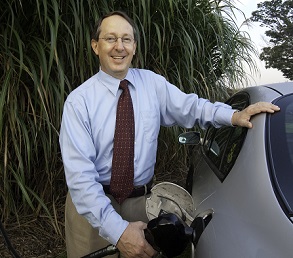WASHINGTON, May 31, 2016 - The 2017 Renewable Fuel Standard (RFS) proposed by EPA disappointed both biofuels and fossil fuels advocates.
That’s because EPA set next year’s mandate for corn ethanol at 14.8 billion gallons – 200 million gallons below the level set by Congress and far short of ethanol industry capacity but well above what the petroleum industry considers acceptable.
In using its contested waiver authority to reduce the RFS volume mandate, the agency announced that EPA remains committed “to increase the use of renewable fuels in the U.S. transportation system every year in order to reduce greenhouse gases (GHGs) and increase energy security.” The 84-page EPA proposal added that despite reducing the 2017 volume requirement, EPA still expects “substantial growth over time in the production and use of renewable fuels.”
Without specifically naming the oil industry, the EPA proposal blamed the lowered volume requirement on “constraints in renewable fuel distribution infrastructure.” In other words, the constraint is the oil industry’s opposition to promoting the use of higher ethanol blends ranging from E15 (15 percent ethanol) to E85 and to installing the blender pumps needed to provide drivers with the choice of higher blends.

Bruce Dale, a chemical engineering professor at Michigan State University, explained to Agri-Pulse that by lowering the overall 2017 biofuels mandate to 18.8 billion gallons from the 24 billion that Congress called for, EPA’s proposal would maintain rather than increase corn ethanol use and “does not move us toward ethanol from cellulosic materials.” Dale isn’t surprised that EPA’s support for biofuels is strongly opposed by the petroleum industry, which he calls “a dying and an obsolete and a polluting industry but a rich one too.” He says the industry, unsurprisingly, is using its market power and wealth to “defend their market share.”
Asserting that oil is “an intensely strategic commodity that drags us into one war after another,” Dale believes that American voters would support a faster transition from petroleum to biofuels “if biofuels were more accurately portrayed.” He says that “for transportation fuels, we have almost no alternatives to oil except biofuels and some electricity. Only large-scale biofuels will prevent continuous war for oil.”
With proven technology for converting biomass to biofuels already in place, Dale says that what’s missing now is “a robust industry to supply cellulosic biomass” as a commodity throughout the country. He points out that it was the grain industry’s ability to supply corn reliably “that enabled the rapid build-out of ethanol from corn.”
Ernest Shea, project coordinator of the 25x’25 Alliance, says the good news is that “the benefits available through biofuels are not in the future, but are demonstrated here and now.” Yet he adds that despite their multiple proven benefits, “biofuels and the low-carbon benefits they provide, especially when compared to fossil-based fuels like gasoline and diesel, continue to fall short of the acknowledgment they deserve.”
Shea told Agri-Pulse that ethanol has become established as an excellent high-octane, low-carbon fuel, but said this fact threatens the petroleum industry.
“What we’re producing is a liquid fuel that is getting cleaner all the time and helping automobile manufacturers deliver on their mandates to produce more efficient vehicles that have less greenhouse gas emissions,” Shea says. “At the same time, petroleum gasoline is getting dirtier and dirtier because the oil that is being refined to produce gasoline is increasingly coming from tighter and tighter oil, which contains more carbon.”

Shea says the comparison between biofuels and fossil fuels “is very threatening to the oil industry and so with their deep pockets, they’re pulling out any and all cards to try to discredit the further acceptance of biofuels and disguise their own shortcomings.”
With the oil industry vastly outspending biofuels on advertising such as the American Petroleum Institute’s “Energy Voter” TV and print campaign, Shea says “they’re bombarding the public with advertising at a scale that far eclipses anything that we could put out…. It is advertising the old myths about biofuels, rather than the facts of today.”
Shea sees the Department of Energy (DOE) as an important ally in supporting biofuels. He notes that DOE’s national laboratories “are consistently producing more and more reports documenting the benefits of ethanol and other biofuels as high-octane, low-carbon fuels.” He expects these reports to have an increasing impact on the public and policymakers now that “the world is committed to a low-carbon future” and “the reality is that the vehicles powered with liquid transportation fuels are going to be with us for many decades to come.” He also sees DOE’s biofuels research “helping to better inform EPA on the policy decisions that they make.” With an unbeatable combination of higher octane and lower emissions, only biofuels offer a proven liquid transportation fuel that “will help the world achieve its climate and greenhouse gas goals,” Shea says.
Despite concerted attacks on ethanol that often cite long outdated statistics rather than current research, Shea notes that the biofuel industry is attracting valuable new partners.
DOE and USDA, for example, are becoming increasingly active, as demonstrated by the joint DOE/USDA announcement May 9 awarding $10 million in funding through the Biomass Research and Development Initiative. Funded projects focus on developing “diverse cost-effective technologies for the use of cellulosic biomass in the production of biofuels, bioenergy, as well as a range of biobased products (including chemicals, animal feeds, and power) that potentially can increase the economic feasibility of fuel production in a biorefinery.”
Shea also welcomes automobile manufacturers as important partners because of their need for the higher-octane, lower-carbon liquid transportation fuels that biofuels provide. “We’re starting to see these new partners step up,” he says, including “petroleum marketers who see a competitive advantage to offering mid-level ethanol blends because there’s extra value in these fuels that attract customers.”
Calling biofuels’ continuing advances “a marathon, not a sprint,” Shea acknowledges remaining obstacles such as tax breaks that continue to favor fossil fuels. But he’s pleased that “there’s a growing, ever-more-diverse coalition of stakeholders coming together in alignment around the high-octane, low-carbon solutions that biofuels offer.”
Tim Wirth, a former Democratic senator from Colorado, and Boyden Gray, White House counsel under President George H.W. Bush, hope to enlarge the biofuels coalition. In an opinion piece published by the Yale Environment 360 forum May 25, the two call on skeptical environmentalists “to reassess their opposition” to ethanol.
“Increasing the ethanol blend in gasoline from the current 10 percent to roughly 30 percent would not only help boost gas mileage, it would significantly cut U.S. carbon emissions and air pollution,” they wrote. Citing recent studies, they conclude that thanks to the latest advances, “ethanol today results in 37 percent less carbon pollution per mile than gasoline.” Adding the currently uncounted benefits of corn’s carbon sequestration could show that corn ethanol is “a zero-carbon fuel,” they say. They also point to savings at the pump from current ethanol use which add up to “nearly $1 per gallon of gasoline . . . That has meant $100 billion per year for U.S. consumers.”
#30
For more news go to: www.Agri-Pulse.com